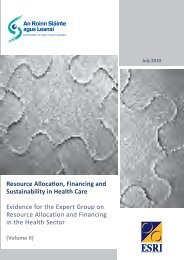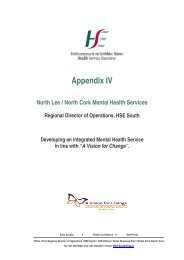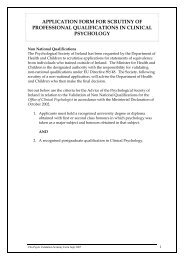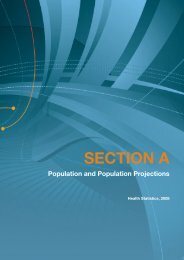Brennan Report - Department of Health and Children
Brennan Report - Department of Health and Children
Brennan Report - Department of Health and Children
Create successful ePaper yourself
Turn your PDF publications into a flip-book with our unique Google optimized e-Paper software.
<strong>Report</strong> <strong>of</strong> the Commission on Financial Management <strong>and</strong> Control Systems in the <strong>Health</strong> Servicetwo staff headed by an Assistant Principal. The <strong>Department</strong> <strong>of</strong> Finance expressed the concernthat internal audit units should have the capacity to enable them to operate effectively <strong>and</strong> tobe well placed to bring to the accounting <strong>of</strong>ficer issues arising from inadequate or ineffectivesystems. The internal audit function in the <strong>Department</strong> <strong>of</strong> <strong>Health</strong> <strong>and</strong> <strong>Children</strong> concentratesonly on the ¤ 30 million or so administrative spending incurred directly by the <strong>Department</strong>.Pending the establishment <strong>of</strong> the Executive, we consider that internal audit systems should beput in place to cover the entire ¤ 9 billion <strong>of</strong> health service spending.Recommendations on Internal AuditR8.8 The Secretary General <strong>of</strong> the <strong>Department</strong> <strong>of</strong> <strong>Health</strong> <strong>and</strong> <strong>Children</strong>, the board <strong>of</strong> the Executive, boards <strong>of</strong> theregional health boards, boards <strong>of</strong> agencies <strong>and</strong> other bodies under the remit <strong>of</strong> health boards <strong>and</strong> boards <strong>of</strong> otherstatutory agencies should ensure that there is an adequately resourced internal audit function. Where it isconsidered inefficient, for reasons <strong>of</strong> scale, for an agency to have a dedicated internal audit unit, the regionalhealth boards should either provide the service centrally or have the function outsourced.R8.9 The internal audit unit should report directly to the non-executive Chairman <strong>of</strong> the audit committee.R8.10 The audit committee should determine powers <strong>and</strong> duties <strong>of</strong> the internal audit unit.R8.11 Internal audit reports should be made available to the external auditor.8.5 RISK ASSESSMENT AND MANAGEMENTDuring the course <strong>of</strong> our work, we encountered a number <strong>of</strong> examples where the assessment<strong>of</strong> risk associated with policy decisions (<strong>and</strong> the management <strong>of</strong> those risks) was not adequatelyundertaken. For example, in Chapter 2, we highlighted the outcome <strong>of</strong> the negotiationsrelating to the extension <strong>of</strong> the medical card to all people over 70 years. In this case, the fullrisk, for a range <strong>of</strong> reasons, was not identified nor arrangements made for the management <strong>of</strong>the risk at the time the decisions were being taken.We believe that the <strong>Department</strong> <strong>of</strong> <strong>Health</strong> <strong>and</strong> <strong>Children</strong> must have a strong, proactive riskassessment role in relation to the development <strong>and</strong> monitoring <strong>of</strong> national policies. This wouldcover two broad areas; risk assessment at policy design stage <strong>and</strong> risk management atoperational/executive levels. We recommend that the <strong>Department</strong> <strong>of</strong> <strong>Health</strong> <strong>and</strong> <strong>Children</strong>substantially enhance its capabilities in this area.Policy Risk AssessmentA pr<strong>of</strong>essional assessment <strong>of</strong> the risks associated with national service development, building inthe necessary control measures in advance <strong>of</strong> the introduction/extension <strong>of</strong> new services, isessential. In this national policy context, risk assessment involves systematically (<strong>and</strong> at the veryearliest stages <strong>of</strong> policy development) analysing, evaluating, monitoring <strong>and</strong> communicating therisks associated with planned activities so that potential losses are minimised <strong>and</strong> opportunitiesare exploited in the best interests <strong>of</strong> the taxpayer.Risk ManagementIn this context, we refer to "risk management" as the ongoing monitoring <strong>and</strong> review <strong>of</strong> systems<strong>and</strong> procedures in place in all bodies responsible for service delivery (the Executive, regionalhealth boards, hospitals, voluntary agencies etc.). As such, we see the risk management function106
















